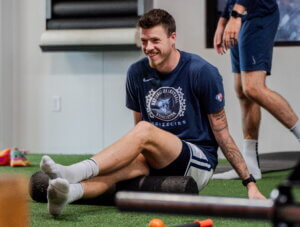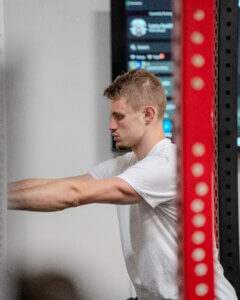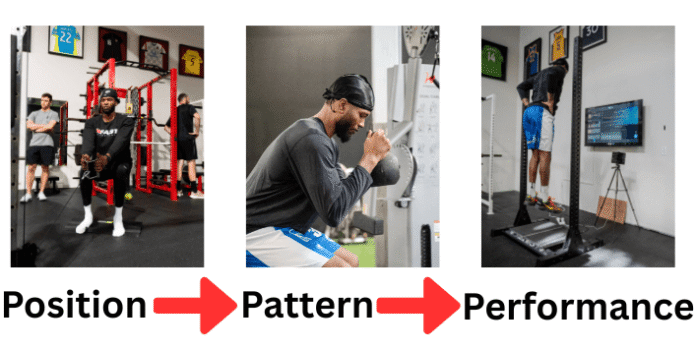As coaches, I think it’s fair to say we all want our athletes to move more efficiently.
Whether it’s squatting, benching and deadlifting, or more athletic movements like accelerations, change of direction and vertical jumps, we all have an “ideal” technical model we’re working towards.
Now that model may change drastically from coach to coach (as I mentioned in my Why I Hate the Term “Movement Quality” article), but I sincerely hope everyone has a model they’re working from.
But one of the things that I’ve found helpful over the years is using a specific sequence to help unlock movements faster
That model is the Position–>Pattern–>Performance approach.
Let’s work through each concept, and then we’ll bring it home with some practical examples at the end!
Unlocking Position
When I was first starting out in the industry, many of us loved to talk about posture.
We’d do static posture pics of our clients and athletes, and then hope to extrapolate everything about their movement from there.
Now keep in mind, this was 20+ years ago – so things like IG, TikTok and YouTube were NOT a thing.
But more importantly, the ability to share videos back then was almost impossible – so static posture pics might be the only thing we could go off of when trying to understand how someone moves.
Fast forward to today, though, and the idea of static posture is probably a little bit antiquated – as it simply reflects how someone is resisting gravity to stand upright.
Instead of posture, I prefer the term position.
Position not only implies that things aren’t “set,” but furthermore, that it’s contextual and that people will get into different positions to execute different activities (i.e. squat, lunge, push-up, etc.)
So the first step in my coaching model is asking myself:
Can the person I’m working with get into the appropriate position to do this exercise?
 Take a squat for example.
Take a squat for example.
If someone’s pelvis is dumped really far forward and they can’t get their hips and pelvis underneath them, then asking them to sit straight down into a squat is going to be almost impossible.
So for this client/athlete the first step in their progression is helping them achieve a more ideal position.
This could be done via any of the following:
- Soft tissue work with a foam roller, lacrosse ball, stick, or any other number of myofascial release tools.
- Resets and targeted breathing exercises to create space.
- Gentle movements like rocking, rolling, etc. where the ultimate goal is to reduce muscle tension and connective tissue stiffness.
I’m sure there are more options here, but you get the point!
The first step in our process is to make sure that our client/athlete has the physical tools – ie the ability to get into the right position – to do the exercise or movement we’re asking them do.
Cool? Lets’ move on to….
Building Patterns
Now that we can hit the necessary positions, it’s time to start rebuilding those patterns.
I feel like people love to argue about what is or isn’t a viable movement pattern, but at the end of the day, it really comes down to what YOU value as a coach.
For instance, I have lots of movements I’m trying to work on in the gym:
- Squats
- Split-Squats
- Single-Leg Squats
- Hinges
- Offset/Staggered Stance Hinges
- Single-Leg Hinges
- Lateral Split-Squats/Lunges
- Horizontal Reaching
- Horizontal Pulling
- Supine Pressing
- Vertical Reaching
- Vertical Pulling
- Integrated Knee Flexion
- Etc.
And that’s just the weight room stuff!
When we get into more of the movement based activities, that list might include:
- Linear Accelerations
- Linear Decelerations
- Linear Top-End Speed
- Lateral Accelerations (Shuffle)
- Lateral Accelerations (Crossover/Lateral Running)
- Backpedaling
- Bilateral Jumps
- Single-Leg Jumps
- Etc
But without getting too far off the grid, let’s circle back to our squat example.
If someone has always had that big anterior orientation/tilt of the pelvis….
….and they’ve always HAD to sit back into their squat because that was the only space available…
…and then you go and unlock their body, that DOES NOT mean they’re magically going to be able to do it correctly!
You gave them ability to move more efficiently, but now they need a software upgrade.
 I love to joke around with my athletes that they’re on iOS 4.0, and we’re trying to get them upgraded to iOS 18 (or whatever is current when you read this!)
I love to joke around with my athletes that they’re on iOS 4.0, and we’re trying to get them upgraded to iOS 18 (or whatever is current when you read this!)
So unlock position, and then help them rebuild that pattern.
Give them the ability to get their hips and pelvis underneath them, and then give them an exercise that will reinforce that same position.
Many times, I find static holds work great here, or even exercises with lighter loads where you can breathe through the movement (i.e. don’t hold your breath!)
The goal here isn’t to crush someone with weight, but to feel what it’s like to move into and out of that position with better technique.
Another way to think about this is if we have a spectrum between Sensory or “Input” based-exercises on one end and Performance/”Output” driven exercises on the other, this is more on the sensory end.
But the end goal here is simple: Take those positions you unlocked earlier in the session and then stack or build on top of it here.
Now hopefully all this is making sense, because we’ve still got one more step in our equation…
Improving Performance
Now the final piece of the puzzle is improving performance.
After all, most of us don’t necessarily care if our pelvis is directly underneath our thorax 24/7.

Or if our squat pattern without load is absolutely perfect.
Instead, we have output driven goals.
We want to squat big weights.
Defy gravity and jump really high.
So this is where the rubber meets the road, so to speak!
Now that we’ve unlocked position and dialed in the movement patterns, it’s time to stress test the system and see if we can do that with:
- A – More Weight,
- B – More Speed, or
- C – Some combination of the two!
Back in the day I used to stratify this further into “Loading” and “Expression” – but I think ultimately performance comes down to what an athlete needs at any given point in time.
Sometimes they need that slow, heavy strength training to develop the architecture and (re)build those connective tissues.
And other times you need that fast, explosive work to prep the body for what it’s going to get into on a field, court or pitch.
Going back to our Sensory/Output continuum, now we’re skewing our training towards the Output side of the equation.
Bigger weights.
Faster movements.
And ultimately, being able to do these things in a way that’s closer to our ideal technical model.
Putting it Into Practice
Okay now let’s put all this into practice.
- Current Issue: The pelvis of our client/athlete is dumped really far forward, and they have to sit back to squat (versus down)
- Training Goals: Unlock the hips and pelvis; stack them underneath the thorax; then rebuild the squat pattern so they can either squat and/or vertical jump with a more upright posture
Sound good?
Great – let’s rock.
First off, here are a few exercises you could use to get the hips and pelvis underneath the torso, and/or create space to shift the center of gravity back.
Next, we want to improve our squat pattern.
I love the PVC reaching squat because it allows me to camp out and FEEL the right things.
However, if you want a more dynamic activity the cable squat works great as well.
Last but not least, we want to unleash performance.
This could be in the form of heavier lifts like 2-KB or traditional front squats…
…or something fast and explosive like a box jump.
Summary
So there you have it – the Position–>Pattern–>Performance approach to unlocking movement.
And while we’ve focused on the squat, I’m sure with a little imagination you can use this framework to help rebuild virtually any movement can think of.
Give it a shot the next time you’re in the gym – I’d love to hear how it works for you!
All the best,
MR
BTW – I’ve had a ton of calls, DM’s and emails over the past couple of weeks with people who are new to my work.
As such, if you’re looking to level up your programming and coaching, here are a few ways you can do just that…
#1 – My Complete Coach Cert
If you want to learn my COMPLETE coaching system – from assessments, to program design, to coaching and cuing – this is it.
#2 – My Starter Products
Not ready to invest in the cert just yet?
Check out one of my starter products to get a better feel for how I program and coach.
#3 – My Program Design Mentorship
Our Fall 2025 group is already rolling, but if you’re frustrated with not getting the results you want, and serious about getting better NOW, fill out the application so I can learn more about your situation.




